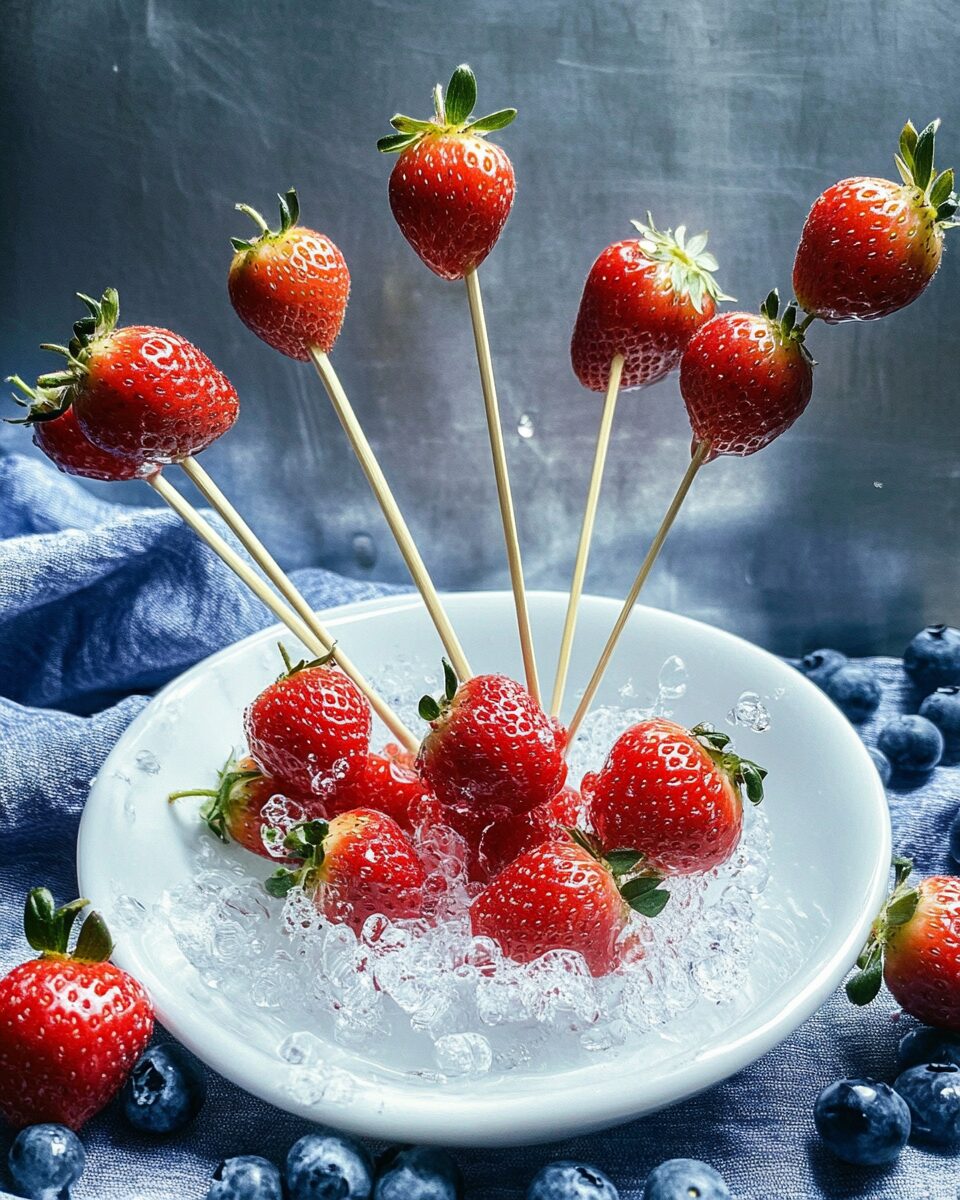Tanghulu is a popular Chinese street food that turns fresh fruit into a crunchy, sugary delight. Coated in a thin layer of hardened sugar syrup, each fruit skewer provides a satisfying crunch followed by the burst of natural fruit flavors. Traditionally made with hawthorn berries, this treat can be customized with a variety of fruits like strawberries, grapes, and pineapple, offering a delightful blend of textures and tastes.
Making Tanghulu at home is surprisingly simple and fun. The process involves just a few ingredients—sugar, water, and your favorite fruits—yet it delivers a stunning result that’s perfect for parties, snack time, or an adventurous dessert. Whether you’re seeking a unique way to enjoy fruit or looking to introduce a piece of Chinese culture to your kitchen, Tanghulu is sure to impress both kids and adults alike.
Full Recipe:
- 2 cups granulated sugar
- 1 cup water
- 1 lb strawberries or other fruit of choice (e.g., grapes, mandarins, blueberries, oranges, pineapple, kiwi)
- Bamboo skewers
Directions:
- Wash and pat dry the strawberries or fruit of choice.
- Arrange the fruit on the bamboo skewers, using 1-3 pieces per skewer.
- In a saucepan, combine the water and sugar. Bring the mixture to a boil.
- Using a candy thermometer, continue boiling the sugar-water mixture until it reaches 300°F (150°C), approximately 5-10 minutes. If you don’t have a thermometer, test the temperature by dipping a spoon into cold ice water and then into the syrup. If it hardens immediately, it’s ready.
- Once the sugar mixture reaches the desired temperature, dip the fruit skewers into the mixture, coating the fruit completely.
- Place each coated fruit skewer on a sheet pan lined with parchment paper or a silicone baking mat. If using parchment paper, spray lightly with cooking spray to prevent sticking.
- The sugar coating should harden almost immediately. Enjoy right away, or store lightly covered with plastic wrap in the refrigerator if needed.
Prep Time: 5 minutes | Cooking Time: 15 minutes | Total Time: 20 minutes
Kcal: 423 kcal per serving | Servings: 4 servings
Background and Origin
Tanghulu, also known as “bing tang hulu” in Mandarin, is a traditional Chinese street food originating from northern China. The snack dates back to the Song Dynasty and is especially popular during the winter season. Traditionally, hawthorn berries were used, which are small, tart, and have a texture similar to that of an apple. These berries are skewered and dipped in a sugar syrup that hardens, creating a crunchy, sweet shell around the fruit. Today, Tanghulu has evolved to include a variety of fruits, making it a versatile and visually appealing treat.
Choosing the Best Fruits for Tanghulu
While hawthorn berries are the traditional choice, other fruits work exceptionally well for this recipe. Here are some options:
- Strawberries: A favorite for their juicy, sweet flavor that pairs perfectly with the crunchy sugar shell.
- Grapes: Provide a juicy pop and are easy to skewer.
- Mandarins: Add a citrusy twist, offering a balance of sweet and tart flavors.
- Blueberries: Bite-sized and perfect for small skewers.
- Pineapple: Offers a tropical flavor that complements the hard candy coating.
- Kiwi: Adds a tangy taste and a beautiful green hue to the skewers.
When choosing fruits, opt for firm and ripe ones that will hold their shape after being dipped in the hot sugar syrup.
Tips for Making Perfect Tanghulu
- Dry the Fruit Thoroughly: Make sure the fruit is completely dry before dipping it into the sugar syrup. Any moisture can cause the syrup to become watery and not harden properly.
- Candy Thermometer: Using a candy thermometer ensures that the sugar syrup reaches the right temperature (300°F or 150°C), creating that iconic crunchy shell. If you don’t have a thermometer, the cold water test (dipping a spoon into cold water and then into the syrup) works as a reliable alternative.
- Work Quickly: The sugar syrup hardens fast. Dip the skewers into the syrup one at a time, coating them quickly, and then place them on the prepared surface.
- Prevent Sticking: Use a silicone baking mat or parchment paper lightly sprayed with non-stick spray to prevent the Tanghulu from sticking as it cools and hardens.
- Storage: Tanghulu is best enjoyed immediately after it’s made for the optimal crunchy texture. If you need to store it, lightly cover it with plastic wrap and keep it in the refrigerator to maintain the candy shell’s crispness.
Variations and Enhancements
- Flavored Syrup: Add a hint of flavor to the sugar syrup with extracts like vanilla, almond, or a splash of citrus juice to enhance the overall taste.
- Colored Sugar Syrup: For a festive twist, add a drop or two of food coloring to the sugar syrup to give the Tanghulu a vibrant and fun appearance.
- Mix of Fruits: Create a medley of fruits on each skewer for a colorful and diverse treat, combining strawberries, grapes, and kiwi on a single stick.
- Sprinkles and Garnishes: For added flair, lightly dust the freshly coated Tanghulu with edible glitter or sprinkles before the sugar hardens.
Serving Suggestions
Tanghulu is versatile and can be served in various ways:
- As a Snack: Perfect for a quick, sweet snack during gatherings or as a fun treat for kids.
- Party Dessert: Impress guests at parties or events with this unique and visually stunning dessert. Arrange the skewers in a tall glass for an eye-catching display.
- Cultural Celebrations: Incorporate Tanghulu into cultural or themed events to give guests a taste of traditional Chinese street food.
Nutritional Information
While Tanghulu is a delightful treat, it’s important to note that it’s high in sugar due to the candy coating. However, the use of fresh fruit provides some nutritional benefits like vitamins, fiber, and antioxidants. Enjoy Tanghulu in moderation as a part of a balanced diet.
Fun Fact
Tanghulu is often sold during Chinese festivals and can be found at outdoor markets, especially during the Lunar New Year celebrations. The shiny, glossy appearance of the skewered fruits adds a festive charm to these occasions.
Historical and Cultural Significance
Tanghulu has been a part of Chinese culinary history for centuries, dating back to the Song Dynasty (960–1279 AD). Traditionally, it was not only a popular snack but also believed to have medicinal properties. The hawthorn fruit, which was the original fruit used in Tanghulu, was known for its digestive benefits and was often consumed after meals to aid in digestion. Over time, this delightful treat has become a beloved street food, especially in northern China, symbolizing joy and celebration. During festivals and the Chinese New Year, Tanghulu is commonly found in markets, adding a touch of nostalgia and cultural heritage to the festivities.
Health Considerations
While Tanghulu is undoubtedly a sugary treat, it can be a slightly healthier alternative to other candies when made with fresh fruits. Here are some health-related aspects to consider:
- Natural Fruits: Using fresh fruits like strawberries, grapes, or kiwi provides a dose of vitamins, minerals, and fiber. For example, strawberries are rich in Vitamin C and antioxidants, while kiwi offers a good source of dietary fiber.
- Moderation is Key: Due to the high sugar content in the candy coating, it’s important to consume Tanghulu in moderation. Enjoy it as an occasional indulgence rather than a daily snack.
- Customizable Sweetness: You can experiment with the sugar syrup’s thickness to control the amount of sugar on the fruit. Using a thinner coating can reduce the overall sugar intake while still providing the iconic crunch.
Advanced Variations
For those looking to experiment and elevate their Tanghulu experience, here are some creative variations and advanced techniques:
- Spiced Sugar Syrup: Add a pinch of cinnamon, star anise, or ginger to the sugar syrup for a warm, spiced flavor that pairs well with fruits like apples or pears.
- Layered Tanghulu: For a more visually stunning presentation, use multiple layers of different fruits on a single skewer. Dip each fruit in the sugar syrup separately to ensure even coating and avoid mixing flavors.
- Alcohol-Infused Tanghulu: For an adult twist, soak the fruits lightly in a splash of flavored liqueur (like Grand Marnier or Amaretto) before skewering and candying. Ensure the fruits are patted dry before dipping into the syrup to avoid the sugar from not adhering properly.
- Flavored Coatings: Besides the standard sugar syrup, try coating the fruit in a honey-based syrup for a different flavor profile. However, note that honey hardens differently than sugar, so expect a slightly varied texture.
Troubleshooting Common Issues
If you’re new to making Tanghulu, you might encounter a few common problems. Here are some troubleshooting tips to help you achieve perfect results:
- Sticky Coating: If the Tanghulu coating remains sticky instead of hard and crunchy, it usually means the sugar syrup didn’t reach the correct temperature. Ensure the syrup reaches 300°F (150°C) to form a proper candy shell. If you don’t have a candy thermometer, the cold water test (as described earlier) is essential.
- Sugar Crystallization: If the sugar syrup starts to crystallize while heating, it can become grainy. To prevent this, avoid stirring the sugar mixture once it begins to boil. If crystallization occurs, you may need to start over with a fresh batch of sugar syrup.
- Burnt Sugar: If the sugar syrup turns brown or smells burnt, it has been heated for too long or at too high a temperature. Sugar burns quickly once it reaches a certain point, so it’s crucial to monitor it closely, especially when approaching the 300°F mark.
- Fruit Slipping off Skewers: To prevent fruit from sliding off the skewers, make sure the fruit is completely dry before skewering. Additionally, choose firmer fruits that hold their shape well when pierced with a skewer.
Serving and Presentation Ideas
Tanghulu is not just a treat; it’s an experience! Here are some ways to serve and present Tanghulu:
- Elegant Platter: Arrange Tanghulu skewers on a decorative platter with a sprig of mint or edible flowers for an elegant presentation at dinner parties or gatherings.
- Tanghulu Bouquet: For a creative twist, create a “bouquet” by placing the skewers in a vase or tall glass, making them look like an edible flower arrangement. This is particularly appealing for themed parties or festive occasions.
- DIY Tanghulu Bar: For events or family gatherings, set up a DIY Tanghulu bar where guests can choose their favorite fruits and watch them get candied on the spot. Provide a variety of fruits, toppings (like crushed nuts or sprinkles), and let guests customize their skewers.
- Kid-Friendly Snacks: For a fun, kid-friendly activity, involve children in the process of making Tanghulu. They can help skewer the fruits and watch as you dip them into the bubbling sugar syrup. Just be sure to handle the hot syrup safely.
Nutritional Benefits of Fruits Used in Tanghulu
While Tanghulu is a sugary treat, the fruits used can offer some nutritional benefits:
- Strawberries: Rich in Vitamin C, manganese, and antioxidants. They help boost the immune system and promote healthy skin.
- Grapes: Contain vitamins C and K, along with antioxidants like resveratrol, which support heart health.
- Kiwi: High in dietary fiber, vitamins C and E, and potassium. Kiwi is known for its digestive benefits and immune support.
- Pineapple: Packed with Vitamin C, manganese, and bromelain, an enzyme that aids digestion.
Conclusion
Tanghulu offers a delightful fusion of simplicity and tradition, transforming fresh fruits into irresistible, glossy treats that captivate both the eyes and taste buds. Whether you’re looking to explore a piece of Chinese culinary heritage or seeking a fun and unique dessert to impress your guests, Tanghulu is the perfect choice. Its versatility allows for endless variations, making it easy to customize to your personal preferences and seasonal fruit availability. Give this charming snack a try, and enjoy the sweet satisfaction it brings to any occasion!






